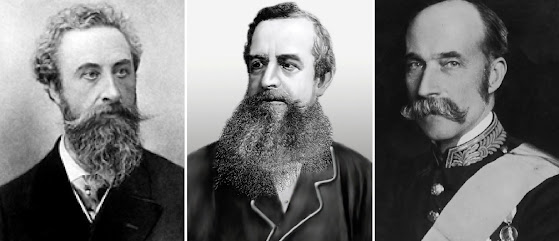Arch (pronounced ahrch)
(1) In architecture, a curved masonry construction for spanning an opening, consisting of a number of wedge-like stones, bricks, or the like, set with the narrower side toward the opening in such a way that forces on the arch are transmitted as vertical or oblique stresses on either side of the opening.
(2) In architecture, an upwardly curved construction, as of steel or timber functioning in the manner of a masonry arch.
(3) A doorway, gateway etc, having a curved head; an archway or the curved head of an opening, as a doorway.
(4) Any overhead curvature resembling an arch.
(5) Something bowed or curved; any bowlike part.
(6) In anatomy, any of various parts or structures of the body having a curved or arch-like outline, such as the transverse portion of the aorta (arch of the aorta) or the raised bony vault formed by the tarsal and metatarsal bones (arch of the foot),
(7) In cobbling, a device inserted in or built into shoes for supporting the arch of the foot.
(8) A dam construction having the form of a barrel vault running vertically with its convex face toward the impounded water.
(9) In glassmaking, a chamber or opening in a glassmaking furnace.
(10) Cunning, crafty or sly.
(11) Playfully roguish or mischievous.
(12) A preeminent person, a chief (largely obsolete except for technical use in ecclesiastical or other hierarchies, (Archdeacon, Archbishop, Archangel, Archduke, monarch, matriarch etc).
(13) One of the basic patterns of the human fingerprint, formed by several curved ridges one above the other.
1250-1300: From the Middle English arch, from the Old English arce, ærce & erce, from the Old French arche, from the Vulgar Latin arca, feminine variant of Latin arcus (arc, a bow), from the Classical Latin atchi, from the Ancient Greek arkhi (to rule). From the Latin, other European languages similarly borrowed including the Old Norse erki, the Dutch aarts, the Middle Low German erse, the Middle High German & German erz and the Gothic ark. Archangel was universally borrowed unchanged from the Greek. Arch was added to many words borrowed from Latin and Greek in the Old English period; it subsequently became a productive form added to nouns of any origin, which thus denote individuals or institutions directing or having authority over others of their class (archbishop; archdiocese; archpriest, archdeacon). More recently, arch, has developed the senses “principal” (archenemy; archrival) or “prototypical” and thus exemplary or extreme (archconservative); nouns so formed are almost always pejorative (archvillain).
Some variations of the arch.
The original meaning, used in architecture of building, bridges and other structures, was by the early fifteenth century applied to eyebrows and anything having this form. The sense of "chief, principal" used first in the twelfth century as archangel became extended to so many derogatory uses that by mid-seventeenth century, it acquired a meaning of "roguish, mischievous" although over time that softened, by the nineteenth century generally understood to mean something like "saucy". The verb arch emerged in the early fourteenth century in the sense of "to form an arch" (which had be implied in the earlier arched) and within a hundred years there was the transitive sense "furnish with an arch". Arch is a noun, verb & adjective, arched is an adjective, arching is a verb, noun & adjective and archly is an adverb; the noun plural is arches.
The Court of Arches
Churches have existed on the site since 1080, the present building designed by Sir Christopher Wren (1632-1723) and built over a decade, finally completed in 1680. The tower has for centuries been noted for its bells which are the source of the legend of Dick Whittington calling him in 1392 back to London where he would sit as lord mayor. In London tradition, to be thought a true Cockney, one had to be born within earshot of the bells so the demographics of that race were interrupted for two decades, the damage inflicted in 1941 by the Luftwaffe so severe it would not be until 1961 the bells again rang.
The Court of Arches is the provincial court for Canterbury. Having both appellate and original jurisdiction, it is presided over by the Dean of the Arches, who is styled "The Right Honourable and Right Worshipful the Official Principal and Dean of the Arches". The dean must be a barrister of ten years' High Court standing or the holder or former holder of high judicial office, the appointment made jointly by the Archbishops of Canterbury and York. Although it has sat in other places, the court’s permanent seat is the Church of St Mary-le-Bow, the arches of which lend the court its name. Technically, the proper jurisdiction of the court is limited to the thirteen parishes belonging to the archbishop in London but, as the office of Dean is united with that of Principal Official, the dean receives and determines appeals from the sentences of all lesser ecclesiastical courts within the province. Many original suits are also heard, where lesser courts waive jurisdiction by letters of request. The original jurisdiction formerly exercised by a separate provincial court, known as the Court of Audience, was long ago abolished.
The official principal of the Arches court is now the only ecclesiastical judge empowered to pass a sentence of deprivation against a clerk in holy orders. The appeals from the decisions of the Arches court were once made directly to the sovereign but are now heard by the judicial committee of the Privy Council except on matters of doctrine, ritual or ceremony, which go to the Court for Ecclesiastical Causes Reserved. Charmingly, the Ecclesiastical Jurisdiction Act 1532, dating from the reign of Henry VIII (1491–1547; King of England 1509-1547) remains one of the statutes empowering the court’s original jurisdiction though since the Matrimonial Causes Act 1857, it no longer hears appeals from the consistory courts of the bishops in all testamentary and matrimonial causes.





















